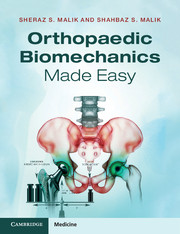Book contents
- Frontmatter
- Dedication
- Contents
- Contributors
- Epigraph
- Preface
- Acknowledgements
- Part I Orthopaedic biomaterials and their properties
- Part II Engineering theory applied to orthopaedics
- 3 Modes of loading in the musculoskeletal system
- 4 Biomechanics of fracture
- 5 Biotribology
- Part III Clinical biomechanics
- Index
3 - Modes of loading in the musculoskeletal system
from Part II - Engineering theory applied to orthopaedics
Published online by Cambridge University Press: 05 June 2015
- Frontmatter
- Dedication
- Contents
- Contributors
- Epigraph
- Preface
- Acknowledgements
- Part I Orthopaedic biomaterials and their properties
- Part II Engineering theory applied to orthopaedics
- 3 Modes of loading in the musculoskeletal system
- 4 Biomechanics of fracture
- 5 Biotribology
- Part III Clinical biomechanics
- Index
Summary
Introduction
This chapter develops on from the force–material interactions considered in the previous chapters. It looks into how solid structures withstand various types of forces. There are four basic modes of loading: compression, tension, bending and torsion. One mode usually dominates in a given loading situation. Therefore, structures can be labelled to highlight their loading mode:
Columns carry compressive forces.
Ties carry tensile forces.
Beams carry bending forces.
Shafts carry torsional forces.
The applied forces generate stress within the structure. The performance of a structure then depends on the properties of the material that it is made from, i.e. material properties, and how and where that material is distributed, i.e. geometric properties.
Material properties
Material properties determine the overall characteristics or personality of a structure. Material properties are the mechanical properties derived from the stress–strain curve, e.g. stiffness, strength and toughness. These properties determine how a structure performs under different types of load, e.g. ductile materials withstand tension better than brittle materials. Material properties are intrinsic to each material and are unaffected by how the material is used. The structure fails when the stress produced within the material reaches its failure limit. Therefore, material properties set the stress limit at which a structure fails. These properties have been considered in detail in the previous chapters.
- Type
- Chapter
- Information
- Orthopaedic Biomechanics Made Easy , pp. 50 - 61Publisher: Cambridge University PressPrint publication year: 2015



